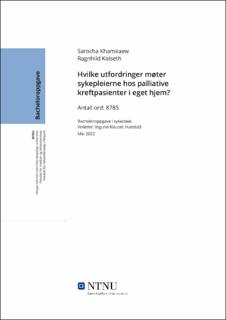| dc.contributor.advisor | Hunstad, Ingunn Klauset | |
| dc.contributor.author | Khamkaew, Sarocha | |
| dc.contributor.author | Kolseth, Ragnhild | |
| dc.date.accessioned | 2022-07-12T17:21:23Z | |
| dc.date.available | 2022-07-12T17:21:23Z | |
| dc.date.issued | 2022 | |
| dc.identifier | no.ntnu:inspera:112446249:113331784 | |
| dc.identifier.uri | https://hdl.handle.net/11250/3004884 | |
| dc.description.abstract | Bakgrunn: Kreft er en av de vanligste sykdommene og kan ramme alle, og ved uhelbrede kreft, vil palliativ behandling sett i gang. Mange ønsker å motta palliativ behandling hjemme, men kun 15% (2015) fikk siste fase av livet i hjemmet. Samhandlingsreformen trådte i kraft i 2012 med mål om at flest mennesker skal få behandling i hjemmet, for å redusere antall innleggelser på sykehus. I tråd med disse faktorene vil det være nødvendig å belyse sykepleiernes utfordringer hos palliative kreftpasienter i eget hjem.
Hensikt: Hensikten med studien er å belyse hvilke utfordringer sykepleierne i hjemmesykepleien opplevde hos hjemmeboende kreftpasienter i en palliativ fase.
Metode: Denne litteraturstudien bygger på åtte kvalitative forskingsstudier.
Resultat: Sykepleiere møtte på utfordringer som manglende kompetanse, dårlig kommunikasjon og bygging av relasjon, samt utfordringer knyttet til rammefaktorene i hjemmesykepleien, eksempelvis tidspress.
Konklusjon: Sykepleierne opplevde det som givende å få ta del i pasientens siste livsfase i hjemmet. Samtidig møtte de på en rekke utfordringer som; manglende samhandling og tverrprofesjonelt samarbeid, kompetanse, dårlig kommunikasjon og tidspress. Konsekvensene av dette kan medføre utrygge sykepleiere, dårlig kvalitet på pleien, innleggelser på sykehus og svekket tillit fra pasient og pårørende. | |
| dc.description.abstract | Background: Cancer is one of the most common diseases and can affect anyone, and in the case of incurable cancer, palliative treatment will be started. Many want to receive palliative care at home, but only 15% (2015) received the last phase of life at home. The co-operation reform came into force in 2012 with the goal that most people will receive treatment at home, in order to reduce the number of hospital admissions. In line with these factors, it will be necessary to shed light on the nurses' challenges in palliative cancer patients in their own homes.
Aim: The aim of the study is to shed light on the challenges that nurses in home nursing experienced in cancer patients living at home in a palliative phase.
Method: This systematic literature study is based on eight qualitative research studies.
Result: Nurses encountered challenges such as lack of competence, poor communication and relationship building, as well as challenges related to the framework factors in home nursing, such as time pressure.
Conlcusion: The nurses found it rewarding to take part in the patient's last phase of life at home. At the same time, they faced a number of challenges such as lack of interaction, competence and interprofessional cooperation, poor communication and time pressure. The consequences of this lead to insecure nurses, poor quality of care, hospitalizations and weakened trust from patients and relatives. | |
| dc.language | nob | |
| dc.publisher | NTNU | |
| dc.title | Hvilke utfordringer møter sykepleierne hos palliative kreftpasienter i eget hjem? | |
| dc.type | Bachelor thesis | |
